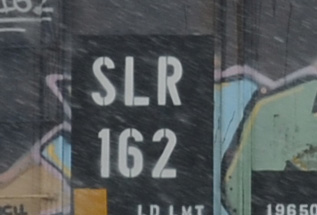
St-Lawrence and Atlantic Railroad. Chemin de fer St-Laurent et Atlantique.
Reporting marks / Identifications : BMS, SLR and SLQ
The history of this line is quite interesting….and a bit confusing!
In 1845; John A. Poor create the "Atlantic and St-Lawrence Railroad" (notice that it is Atlantic and St-Lawrence not the other way around!). The goal of this company is to have a railroad that connect Sherbrook in Quebec to an Ice free port, in this case; Portland in the USA using tracks that were design under the "Portland gauge" (5ft 6 in).
In 1851, the "St-Lawrence and Atlantic Railroad" is created to connect the tracks from the "Atlantic and St-Lawrence Railroad" to a track that would bring it to Montreal (St-Lambert, before they built the Victoria bridge).
In 1853, the "Grand Trunk Railway" lease both companies to have a line from Portland and Montreal. During that time, the Portland port build huge grain elevator to handle traffic of goods on these lines.
In 1873, the gauge of the lines between Portland and Montreal is changed to "standard gauge" (4ft 8in). This is an interesting story. The last train with Portland gauge that was schedule September 26th, went at 2 am. Crews were dispatch to change the gauge of the rails after lots of preparation (new spike lay at every ties who themselves were prepared to receive the new gauge in advance. Some siding were already changed in advance too!). These crews (2 crews of 8 men for every 5 miles of tracks) slept near the tracks with their tools at the ready. When the last train went, they started to do the change and by 9 am the same day, the changes were made.
In the 1920's, when the "Grand Trunk Railway" when bankrupt and the CNR was created, the Portland-Montreal line became a secondary line since the CNR already had better lines to an ice free port (Halifax, Nova Scotia). The newly birth of the trucking industry almost killed the company until the 1930's were tourism became popular and twice a week, trains from Montreal would bring people to Portland.
During the war it had a short new lease on life when it was used to carry merchandise to Montreal because it was safer than the St-Lawrence River (U-boat threat) where boat used to be the favorite carrier.
At the end of the 1980's following the deregulation in both the USA and Canada; the line is now used to bring traffic from Portland to Ste-Rosalie (in Quebec) where it connects to the main CN lines.
In 2002 the two companies were bought by the Genesee and Wyoming Railway and even today, the two companies managed their original portion of the tracks.
They own (or lease) about 162 miles of tracks, and about a thousand (1000) cars.
L'histoire de ce tronçon de chemin de fer est très intéressante et confus!
En 1845, John A Poo créer le " Atlantic and St-Lawrence Railroad" (remarqué que c'est Atlantic and St-Lawrence et non pas de contraire!). Le but est de créer une ligne de chemin de fer entre Portland, un port sans glace en hiver, à Sherbrooke au Québec, en utilisant des voies de fer aux normes " Portland gauge " (1.7m).
En 1851, le " St-Lawrence and Atlantic Railroad " est créé pour faire la connexion entre les voies du " Atlantic and St-Lawrence Railroad " et Montréal (St-Lambert, avant la construction du pont Victoria).
En 1853, le "Grand Trunk Railway" loue les opérations des deux compagnies pour avoir une ligne entre Portland et Montréal. Pendant ce temps, le port de Portland bâtis deux immense élévateurs de grain pour la manutention de la marchandise sur ces lignes.
En 1873, la norme des voies de chemin de fer entre Portland et Montréal est changée de la norme Portland à la norme " standard " (1.44m). Ici, nous avons droit à une histoire intéressante : Le dernier train à la norme " Portland " qui circule sur les voies, le fait le 26 septembre à 2 AM. Des équipes ont été préalablement envoyées sur place auparavant. Des préparations ont été faites à l'avance; des nouveaux clous de rail ont déjà été déposés sur chaque traverse et ceux-ci sont déjà prêts à recevoir le nouvel emplacement de rail. (Certaines des voies de dépassements sont déjà modifiées). Les équipes (2 équipes de 8 hommes pour chaque 8km) dorment à côté de la voie. Quand le dernier train passe; les hommes se mettent immédiatement au travail et à 9 AM la même journée, le changement est terminé.
En 1920, quand le " Grand Trunk Railroad " déclare faillite et que le gouvernement Canadien créer le CNR; la ligne Portland - Montréal devient une ligne secondaire vu que le CNR possède une meilleure ligne entre un port en eau libre (sans glace, Halifax, Nouvel Écosse). La naissance de l'industrie du camionnage tue pratiquement cette ligne, jusqu'aux années 1930 ou l'industrie du tourisme nait. Pendant plusieurs années, 2 trains par semaines amène les touristes de Montréal à Portland.
Pendant la 2 ième guerre, cette ligne connait un certain succès quand les eaux du St-Laurent deviennent dangereuses pour la circulation maritime à cause des U-boats..
À la fin des années 1980, avec la dérégulation autant aux USA qu'au Canada; cette ligne est maintenant utilisée pour connecté Portland à Ste-Rosalie (au Québec) aux lignes du CNR.
En 2002 le "Genesee and Wyoming Railway" achète les deux compagnies et même aujourd'hui, les deux compagnies originales continues de faire la gestion de leurs voies respectives.
Entre eux deux, ils possèdent environ 260 Km de voies et environ mille (1000) wagons.
To go back to the companies' page / Pour retourner à la page des comnpagnies
To go back to the menu page / Pour retourner à la page du menu